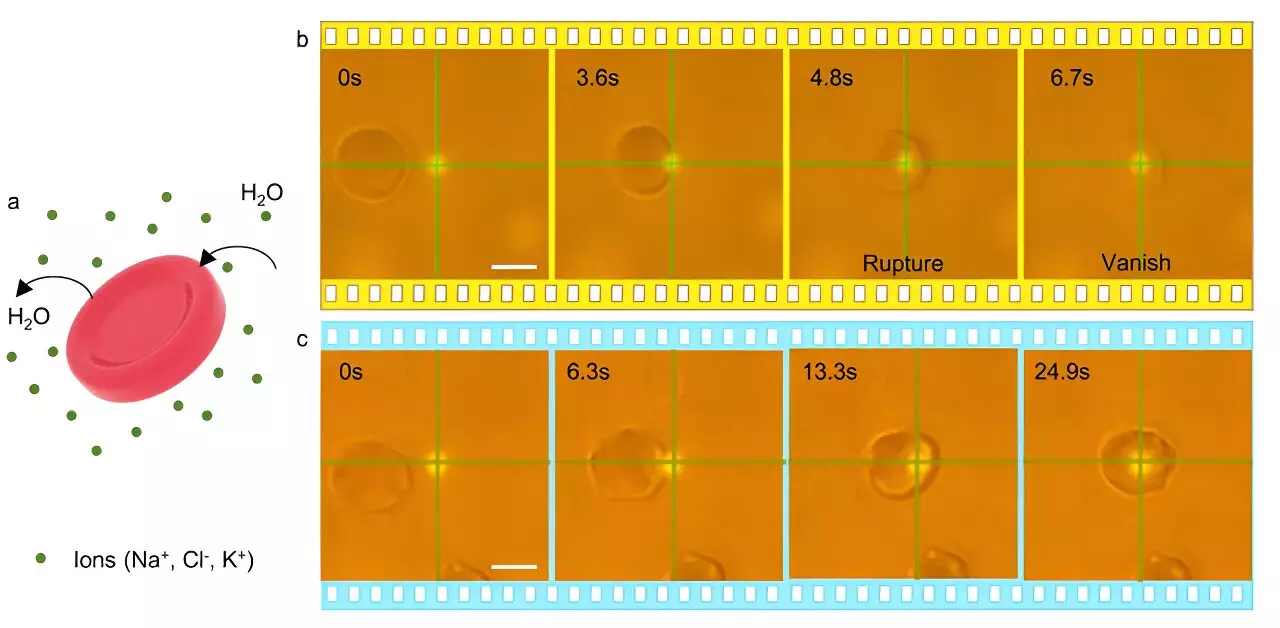In the realm of scientific advancements, optical tweezers have emerged as a groundbreaking technology with numerous applications in fields like cancer therapy and environmental monitoring. These devices, which utilize lasers to manipulate tiny particles such as cells and nanoparticles, were even honored with a Nobel Prize in 2018. Now, a team of scientists has taken optical tweezers to new heights by employing supercomputers to enhance their safety and efficacy when used on living cells.
Led by Pavana Kollipara, a recent graduate of The University of Texas at Austin, this team of researchers has developed a novel method called hypothermal opto-thermophoretic tweezers (HOTTs). They believe that this research brings us one step closer to the industrialization of optical tweezers in biological applications, particularly in selective cellular surgery and targeted drug delivery. The study, which was published in August 2023 in Nature Communications, marks a significant contribution to the field of mechanical engineering.
To comprehend the significance of this breakthrough, we must first delve into the fundamentals of optical tweezers. These devices can trap and move tiny particles by utilizing the momentum of light, which can then be transferred to the impacted particle. By intensifying the light through lasers, the trapping power is enhanced. However, one of the limitations of current laser light tweezers arises from the excessive heat generated during the process, which can be detrimental in biological applications.
In response to this challenge, Kollipara and her team developed the HOTTs method, which ensures that the targeted particle remains cool throughout the process. They achieved this by incorporating a heat sink and a thermoelectric cooler into the optical tweezers system. Through this innovative approach, HOTTs enables low-power trapping of diverse colloids and biological cells in their native fluids. This development addresses the issue of heat-induced damage to the sample, allowing the trapping process to occur at a lower laser power and under controlled temperatures. These improvements significantly minimize photon or thermal damage to the cells, making optical tweezers safer and more effective for biological applications.
One notable outcome of this research is its impact on sensitive cells, such as human red blood cells. Conventional optical tweezers often cause irreparable damage to these cells, leading to their immediate demise. However, using the HOTTs method, Kollipara and her team successfully demonstrated the ability to safely trap and manipulate these cells, regardless of the solution they are dispersed in. This breakthrough finding holds immense potential for various medical applications, including cancer therapy and drug delivery.
The applications of optical tweezers extend beyond cellular manipulation. By utilizing plasmonic vesicles, which are tiny gold nanoparticle-coated bio-containers, Kollipara and her team were able to trap these vesicles without displacing them within a solution. This outcome serves as an analogy for guiding drugs to specific targets within the body. Once these plasmonic vesicles reach the designated target, a secondary laser beam is used to burst open the drug cargo, enabling precise drug delivery. This targeted drug administration approach significantly reduces the amount of drugs consumed by patients and allows for greater control over drug administration locations.
The Role of Supercomputers
Implementing these advancements in optical tweezers required extensive computational analyses. Throughout their research, Kollipara and her team relied on supercomputers, such as TACC’s Stampede2 and Lonestar5 systems. These powerful machines, which are part of the University of Texas Research Cyberinfrastructure (UTRC), have provided invaluable support by generating results at a much faster rate than local workstations could ever achieve. The complex simulations conducted on these supercomputers have facilitated the understanding of 3D force magnitudes on particles, taking into account optical, thermalphoretic, and thermoelectric fields.
The breakthroughs achieved in this study pave the way for the wider adoption and industrialization of optical tweezers in various fields of biology and medicine. The HOTTs method, with its capability to trap and manipulate cells at lower laser powers and controlled temperatures, opens new avenues for selective cellular surgery and targeted drug delivery. Moreover, the integration of supercomputers into the research process ensures that these advancements can be implemented effectively, providing scientists with valuable tools for further discoveries in biomedical engineering.
The development of safer and more efficient optical tweezers through the HOTTs method demonstrates the potential of this technology in revolutionizing biological applications. With the ability to trap and manipulate cells while minimizing thermal and photon damage, optical tweezers hold great promise in areas such as cancer therapy and drug delivery. As scientists continue to push the boundaries of innovation, the collaboration between technological advancements and computational power will undoubtedly lead to even more fascinating discoveries in the field of optical tweezers.


Leave a Reply